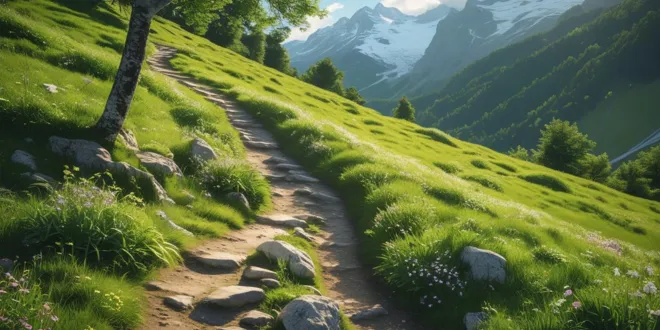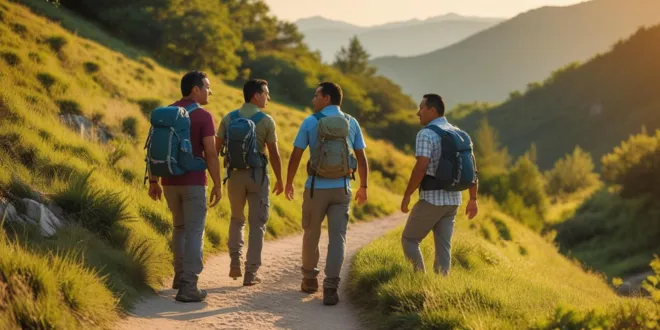The Tour du Mont Blanc (TMB) stands as one of Europe’s most celebrated long-distance hiking trails, circling the majestic Mont Blanc massif across France, Italy, and Switzerland. This Famous Tour du Mont Blanc Hike attracts thousands of adventurers annually, offering breathtaking alpine scenery, charming mountain villages, and challenging terrain.
Whether you’re a seasoned trekker or Tour du Mont Blanc for First-Timers, this 170-kilometer circuit promises an unforgettable experience through the heart of the Alps.
Our Tour du Mont Blanc Complete Guide will equip you with everything needed for this epic adventure. From essential preparation tips to detailed route information, we’ll show you How to Hike Tour du Mont Blanc successfully.
This comprehensive guide covers accommodation options in mountain refuges, required fitness levels, best timing for your journey, and crucial packing advice. Whether you’re planning your first alpine trek or seeking to conquer Europe’s most iconic hiking trail, the Tour du Mont Blanc offers spectacular rewards for those ready to embrace its challenges.

The Tour du Mont Blanc
The Tour du Mont Blanc (TMB) is Europe’s most celebrated long-distance hiking trail, encircling the majestic Mont Blanc massif across three countries: France, Italy, and Switzerland. This legendary 170-kilometer circuit offers hikers unparalleled Alpine experiences, passing through charming villages, pristine valleys, and dramatic mountain landscapes.
The trail typically takes 7-12 days to complete, with daily distances ranging from 15-25 kilometers. Hikers traverse diverse terrain including forest paths, rocky trails, and high mountain passes reaching up to 2,500 meters elevation. The TMB showcases the best of Alpine culture, with opportunities to experience French, Italian, and Swiss mountain traditions.
Each section presents unique challenges and breathtaking viewpoints, making it one of the world’s premier trekking destinations. The route’s popularity stems from its accessibility, well-maintained paths, and the network of mountain refuges providing accommodation and meals. Whether you’re seeking adventure, natural beauty, or cultural immersion, the Tour du Mont Blanc delivers an unforgettable Alpine experience that attracts thousands of hikers annually from around the globe.
Tour du Mont Blanc Complete Guide
A comprehensive Tour du Mont Blanc guide encompasses every aspect of planning and executing this iconic Alpine adventure. Essential elements include detailed route information with daily stage descriptions, elevation profiles, and estimated hiking times. Accommodation options range from basic mountain refuges to comfortable hotels, requiring advance booking during peak season. Budget planning should account for transportation, lodging, meals, and equipment costs, typically ranging from €800-2000 depending on preferences.
Physical preparation involves months of cardiovascular training and practice hikes with elevation gain. The guide should cover essential gear lists, weather considerations, and safety protocols. Cultural insights about the three countries traversed enhance the experience, including language basics and local customs. Emergency procedures, insurance requirements, and permit information are crucial components.
A complete guide also addresses alternative routes, side trips, and flexible itinerary options. Photography tips for capturing Alpine beauty and environmental responsibility guidelines ensure sustainable trekking practices. This comprehensive resource empowers hikers to make informed decisions throughout their TMB journey.
How to Hike Tour du Mont Blanc
Successfully hiking the Tour du Mont Blanc requires strategic preparation and execution. Begin with physical conditioning at least 3-4 months prior, focusing on cardiovascular endurance and leg strength through regular hiking, running, or stair climbing. Invest in quality hiking boots, waterproof clothing, and appropriate technical gear.
Plan your route carefully, considering seasonal variations and weather patterns. Book accommodations well in advance, especially popular refuges during peak summer months. Understand the logistics of border crossings between France, Italy, and Switzerland, ensuring proper documentation and visas if required.
Pack efficiently with a balanced load not exceeding 10-12 kilograms. Start each day early to avoid afternoon weather changes and complete challenging sections during optimal conditions.
Stay hydrated and maintain energy levels with regular snacks. Follow marked trails and respect local regulations. Learn basic French, Italian, and German phrases for communication in different sections. Monitor weather forecasts daily and be prepared to modify your itinerary if necessary. Carry emergency communication devices and inform others of your daily plans.

The Famous Tour du Mont Blanc Hike
The Tour du Mont Blanc’s fame stems from its unique combination of accessibility, spectacular scenery, and cultural diversity. As one of the world’s premier trekking circuits, it attracts hikers from every continent seeking Alpine adventure. The trail’s reputation is built on its well-maintained infrastructure, including clearly marked paths and reliable refuge network.
Each country contributes distinct characteristics: French sections offer sophisticated mountain cuisine, Italian portions provide warm hospitality and Mediterranean influences, while Swiss areas showcase precision and efficiency. The hike’s fame extends beyond physical challenge to include spiritual and emotional rewards.
Many describe transformative experiences amid towering peaks, pristine glaciers, and ancient mountain villages. Social media and travel literature have amplified its popularity, creating a global community of TMB completers. The trail’s recognition includes inclusion in various “bucket list” hiking adventures and outdoor publications. Environmental conservation efforts maintain its pristine condition, ensuring future generations can experience its legendary beauty. The sense of accomplishment upon completing the circuit creates lasting memories and often inspires return visits or exploration of similar Alpine adventures.
Tour du Mont Blanc for First-Timers
First-time Tour du Mont Blanc hikers should approach this legendary trek with careful preparation and realistic expectations. Begin training 4-6 months in advance with regular hikes carrying a weighted backpack, gradually increasing distance and elevation gain. Start with shorter Alpine treks to acclimate to mountain conditions and test equipment.
Choose less crowded periods like late June or early September for easier accommodation booking and more flexible scheduling. Consider booking a guided tour initially for added safety and logistical support. Pack light but include essential emergency gear, extra clothing layers, and quality hiking boots broken in well before departure.
Plan rest days for acclimatization and weather contingencies. Start each stage early to avoid afternoon thunderstorms common in Alpine environments. Connect with other hikers for motivation and shared experiences, as the TMB community is generally supportive and helpful. Set daily goals based on your fitness level rather than ambitious schedules.
Document your journey through photos and journaling to capture memories. Remember that completing the circuit is an achievement regardless of speed, and flexibility in planning often leads to better experiences than rigid adherence to schedules.

Conclusion
The Tour du Mont Blanc remains The Famous Tour du Mont Blanc Hike that continues to captivate adventurers from around the globe with its unparalleled alpine beauty and challenging yet rewarding terrain. Whether you’re Tour du Mont Blanc for First-Timers or experienced hikers seeking your next great adventure, this iconic circuit offers memories that will last a lifetime.
This Tour du Mont Blanc Complete Guide has provided you with essential insights into planning, preparing, and successfully completing this legendary trek. Remember that proper preparation is key to enjoying How to Hike Tour du Mont Blanc safely and comfortably. From choosing the right season and accommodation to packing appropriate gear and building your fitness level, every detail matters for a successful TMB experience.
The Tour du Mont Blanc is more than just a hiking trail – it’s a journey through three countries, diverse cultures, and some of Europe’s most spectacular mountain landscapes. With careful planning and the right mindset, this incredible adventure awaits every determined hiker ready to circle Western Europe’s highest peak.
Frequently Asked Questions
1. How long does it take to complete Tour du Mont Blanc?
The complete Tour du Mont Blanc typically takes 7-12 days to finish. Most hikers complete it in 8-10 days, covering approximately 170 kilometers with daily distances of 15-25 kilometers. The duration depends on your fitness level, weather conditions, and rest days planned.
2. What is the best time of year to hike Tour du Mont Blanc?
The optimal hiking season is from mid-June to mid-September when trails are snow-free and refuges are open. July and August offer the best weather but are busiest. Early June and late September provide fewer crowds but require more preparation for variable conditions.
3. How much does Tour du Mont Blanc cost for Iranian travelers?
Total costs range from €800-1500 for budget travelers to €2000+ for luxury options. Major expenses include accommodation (€30-120/night), meals (€20-50/day), transportation, gear, and optional guide services. Iranian travelers should budget accordingly for this Alpine adventure.
4. Is Tour du Mont Blanc difficult for beginners?
TMB is moderately challenging but achievable for beginners with proper preparation. While not technically difficult, it requires good physical fitness and endurance for daily 6-8 hour hikes. First-timers should train adequately and consider starting with shorter Alpine treks before attempting TMB.
5. Do Iranians need a visa for France, Italy, and Switzerland?
Yes, Iranian citizens need Schengen visas for all three countries. Since TMB crosses borders, you’ll need a multiple-entry Schengen visa valid for at least 15-20 days. Apply through the embassy of your main destination country, providing detailed itinerary and financial proof.
6. What fitness level is required for Tour du Mont Blanc?
You need excellent cardiovascular fitness and leg strength. Training should include 2-3 hour hikes with elevation gain, regular cardio exercises, and strength training 2-3 months before departure. Ability to carry a 10kg backpack for 6-8 hours daily is essential for successful completion.
7. How to book mountain huts (refuges) on TMB route?
Book refuges through official websites like Cicerone or individual hut websites, 3-6 months in advance. Popular huts fill quickly, especially in peak season. Have backup accommodation plans and consider booking alternate routes. Credit cards are widely accepted, but carry some cash for smaller huts.
8. What should I pack for Tour du Mont Blanc trek?
Essential items include waterproof jacket and pants, hiking boots, warm layers, sleeping bag liner, headlamp, first aid kit, and sun protection. Pack light but include emergency gear. Most hikers carry 30-40 liter backpacks with clothing for 4-5 days plus technical hiking equipment.
9. Are there alternative shorter routes available?
Yes, several options exist including 3-5 day sections like Chamonix to Courmayeur or Les Contamines loop. The “Tour du Mont Blanc Express” combines hiking with train travel. These alternatives suit time-constrained travelers while experiencing TMB’s highlights without committing to the full circuit.
10. Can you hike Tour du Mont Blanc solo?
Absolutely! Many hikers complete TMB solo successfully. The well-marked trail and frequent refuge encounters ensure safety. Inform someone of your daily plans, carry emergency communication devices, and check weather conditions regularly. Solo hiking offers flexibility but requires extra caution and preparation.
